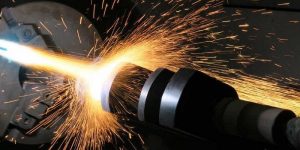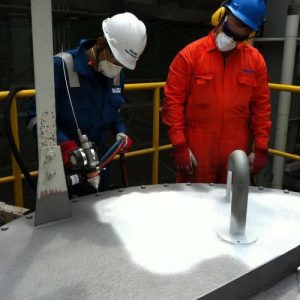
24 Feb Six Features of Thermal Spray Coating
Thermal spray coating involves a source of heat that is used to melt a protective substance on to another material, coating it in droplets that solidify to form a coating.
It’s a popular process with a lot of different uses, benefits and features. Here are some of them.
Size Recovery
Thermal coating is a useful (and not to mention cost-effective) way to return a piece of workwear to its original size. Machine components, for example, undergo routine wear that can reduce their size and hinder their operational capacity. Recovering the size of these objects can be costly, especially if special plating methods are used. Thermal spray is a much cheaper and easier alternative, and it has some other distinct benefits too. Not only will the object recover its size, but it will now have a hard resistant surface, making it less prone to wear in the future.
Increased Hardness
A variety of industrial processes can cause a component to wear or become damaged. Friction, impact and sliding all have detrimental effects that contribute to significant degradation over time. Thermal plasma spray coating gives materials additional hardness and is used to make them more wear-resistant. It’s popular in a range of industries and is even used to make the engine blades on aeroplanes resistant to erosion and air impact.
Creates a Thermal Barrier
As outlined by Science Direct, one of the biggest benefits of thermal spray coating is how effectively it creates a thermal barrier. Spray coatings are frequently used on engine parts, where the applied substance creates a heat-resistant barrier. Flame stabilisers, valves and gas turbines can also benefit from a thermal plasma spray coating, which helps them maintain their function in high heat and pressure environments where other plating techniques may fail.
Chemical Resistance
The chemical-resistant properties of spray coating work to protect both the coated surface and anything contained within it. For example, thermal spray is often applied to freight cars that carry liquids. The coating preserves the liquid’s purity and, in the case of corrosive liquids, protects the container as well. Spray coatings are favoured to protect pipelines that supply fresh water and as a way to protect the underside of ships from corrosion.
Cavitation Resistance
Coatings such as those offered at https://www.poeton.co.uk/standard-treatments/plasma-coatings/ give excellent cavitation protection. Anti-cavitation spray coatings have been applied to wellhead devices since the 1950s as a way to ensure long-term protection and functionality. These coatings are widely used elsewhere too – on cooling towers and gas and oil tanks.
Oxidation Resistance
The oxidative protection offered by spray coating is so effective that it can increase the longevity of some materials by up to five times. Special oxidation-resistant sprays are used to treat jet engine parts, including combustion chambers, which are exposed to high temperatures and oxidation when in use. High-temperature oxidation poses challenges in a variety of industries, and resistant sprays are also used coat the inside of factory chimneys and ships.



No Comments